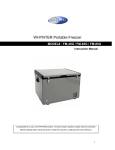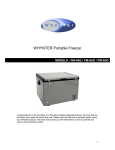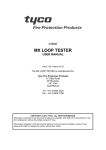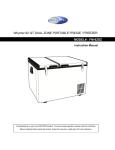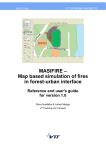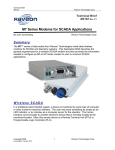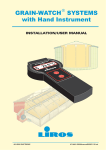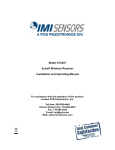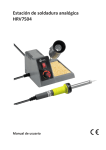Download MXF100 Optical
Transcript
usethisnewPSF111U.QXD 28/3/02 11:08 pm Page 3 Minerva FIRELINE Applications • MXF100 Optical Fibre Temperature Sensing Technology Power Stations MoD Property Road and Rail Tunnels Mass Transit Railway Systems Petrochemical and Oil Terminals Airport Terminals and Hangars Process Plants, Distilleries, Escalators Roof Tanks, Warehouses and Cold Stores Cable and Utility Tunnels Data Processing Centres Parking Garages Conveyer Belts Offshore • The Minerva Fireline MFX100 is a revolutionary laser and fibre optic based Linear Heat Detection system providing a fast, flexible and highly resilient means of detecting fires and protecting both people and plants in a wide variety of risks. The technology is well proven and has already been specified and successfully installed in many different applications. usethisnewPSF111U.QXD 28/3/02 11:09 pm Page 4 Optical Fibre Temperature Sensing Technology Introduction The Minerva Fireline MXF100 uses a combination of powerful laser technology and computer processing to provide fast and accurate temperature measurement along a 2 Km loop of fibre optic cable. Precise fire and sensor cable break detection can be determined within an accuracy of 1.25m. The MXF100 provides a flexible programmable platform to suit many different risks and can be easily integrated into the overall fire protection systems. The main features of the system are: Automatic detection and full recovery from sensor cable break Safe (Class 3A) laser operation Continuous ‘live’ assessment of the development of fires Wide range of programmable temperature operating modes and alarm thresholds Up to 100 programmable alarm zones Unaffected by Electromagnetic Interference (EMI) Suitable for use in designated Hazardous Areas MXF Manager Software The MXF Manager (Windows) software is used as an interface to the MXF100 control unit. By using this software, it is possible to configure the MXF100 unit to suit the particular fire risk. The system is password protected and can be set up to provide a continuous display of system status on a dedicated PC. Figure 1. Temperature Profile & Alarm Display Figure 1 Illustrates the temperature profile display for the entire fibre length and also a numerical display for individual zonal temperatures. Summary of Cable Features . . . . . Low thermal mass for rapid response to temperature Low smoke halogen free jacket, with excellent flame retardancy. Suitable for all indoor applications Stainless steel clad fibre optic cable suitable for all harsh area applications Strong, lightweight and flexible Designed for ease of installation usethisnewPSF111U.QXD 28/3/02 11:09 pm Page 5 Optical Fibre Temperature Sensing Technology BENEFITS FEATURES D IR E C T P C C O NN E C TI O N This enables a user to view the temperature profile for the risk. It also provides an interface to allow adjustment of the alarm trip levels - this is access level protected. C O NT IN U O U S T E M P E R A T U RE P R O F I LE S By connecting a PC, it is possible to monitor the entire sensing cable length to view the current stratus of the alarm system which assists in easily determining the proximity to an alarm state. P R O G R A M M AB L E N U M B E R A N D L E N G TH O F F I R E D E T E CT I O N Z O N E S A singe cable length can be divided into multiple fire detection zones thereby giving increased system flexibility whilst keeping cable lengths to a minimum. V AR I A B L E R A T E O F R I S E A N D F I X E D T E M P E R AT U R E F U N C T I O N Variable rate of rise and fixed temperature alarm levels, ensure a flexible heat detector sensitivity which can be tailor made to give an early warning signal, dependant on the fire risk. M U LT IP L E & P R O G R A M M A B L E A L A R M L E V E L S PE R F I R E D E T E C TI ON Z O N E Pre- alarm warnings can be given, prior to a full alarm condition, thus helping to ensure minimal plant downtime. U N R I V A LL E D R E S P O N S E T IM E The sensing element is designed to respond very quickly to changes in ambient temperature thus ensuring an early warning heat detection system. MXF100 Control Unit Alarm information is obtained quickly from the powerful and Pulsed Laser intelligent MXF100 processor. The control unit uses a laser light source to launch light signals into the optical fibre. Please refer to fig.2 for Operating Principal diagram. As pulses travel down the fibre , energy is lost t hrough Signal Processing scattering. A fraction of the scattered signal is retained within the fibre. A portion of this is directed back along the fibre towards the laser source - this signal is called back- Signal Processing Data Acquisition Optical Receiver scatter. Part of the back-scatter signal (Raman Scattering) is used to provide accurate remote temperature measurements Fig. 2 MXF100 Operating Principle at hundreds of points along the fibre. The MXF100 control unit is housed in a robust wall mounted cabinet with a style and livery matching that of the latest range of Minerva MX control panels. it contains the MXF100 sensor cable analyser and provides local alarm and fault indications, a PSM800 4A power supply module, field terminals for connection to signalling relays and a termination box for the fibre optic splice joints to the sensing cable. It requires externally mounted standby batteries. System Architecture The MXF100 provides output options, which operate concurrently to provide system design flexibility. 22 programmable relays can be used to map out alarm zones into a fire panel, either directly or via addressable interface modules such as the MX CIM800. Protocol definition data is given to enable the MXF100 to be connected via a PLC to a centralised control and monitor information centre, e.g. SCADA. Definition for a bespoke MXF protocol is also available to enable the development of alternative graphics display interfaces. The full 200-zone capability of the system can be exploited using either the Modbus and MXF protocols. Figure 3 shows typical system architecture. usethisnewPSF111U.QXD 28/3/02 11:09 pm Page 6 . Optical Fibre Temperature Sensing Technology USER Sensor Cable MXF100 MXF Protocol ~ PSU 24V Remote PC Modbus PLC SCADA Relays ADDRESSABLE RELAY INTERFACES FIRE ALARM PANEL Fig. 3 Minerva Fireline MXF100 Typical System Layout BENEFITS FEATURES F I B R E O P T I C S E N S O R L O O P Very long distance (large areas) can be monitored using a single length of heat sensing cable. The hot spot identification on a 2 Km length of fibre optic sensing U P TO 2 K m cable, is to within 1.25metres. P ROG R AMM ABL E RE L AY CO NT AC TS 22 zonal relays ensure that the system can provide sufficient alarm notifications – typically directly to any Fire Alarm Control Panel. 2 relay contacts are reserved for system and sensor fault. MOD BU S O UTP UT PO RT Permits connection of the system to any PLC (programmable logic controller) or DCS (distributed control system) using industry standard communications, thereby providing a very flexible system topology. H I G H S Y S T E M I N T E G RI TY The system can be set to operate in either single ended or loop mode without any additional costly hardware. The system continuously monitors the integrity of the loop and continues to operate in the event of a cable fault. The system is designed with an automatic loop break recovery operation. AUT O M ATIC FA ILUR E MO DE A NA LY SI S Cable faults are detected to an accuracy of ±1.25m. The control system is continuously monitoring and a full syntax of fault information is provided with the system. S AFE L ASE R SO UR C E In the event of a cable failure, where the laser light source may be exposed, the laser light is determined a safe source in accordance with IEC825. D I A GN O S T I C C A P A B I L I T Y Enables interrogation of the system to determine system status. M OD EM INT ER FA CE By using a remote PC with a dial up connection to the host PC on site, it is possible for system to be accessed from a remote location to help assist with on-line technical support. The Optical Fibre Sensor The MXF100 uses standard communications grade optical fibre of the 62.5/125 graded index multimode type. The temperature range is predominantly a function of the coating used to protect the optical fibre as the fibre itself is well behaved over a temperature range from -50ºC to approximately 300ºC. Coatings have been tested down to -190ºC (acrylate) and up to 460ºC (metallic). Optical fibre itself offers several advantages as a sensing medium. The signals are immune to electromagnetic interference thereby ensuring integrity of readings from electrically noisy areas. As no electrical current is used in the sensing fibre and the fibre is a relatively inert and dielectric (non-conducting) medium, it is safe technology to use in hazardous environments. usethisnewPSF111U.QXD 28/3/02 11:08 pm Page 1 Optical Fibre Temperature Sensing Technology MXF100 Cable Options The fibre used in this system is based upon standard 62.5/125 fibre optic cable. The cable has been further modified by adding This cable is specifically designed for all indoor applications and is suitable for some outdoor installations. When used out of a choice of two external sheaths which provide additional mechanical strength to the fibre. Gel filled loose tube technology protects the fibre from mechanical and environmental damage, doors it should be suspended above the ground using, for example, a catenary wire or cable tray. It will withstand occasional contacts with hydrocarbons such as kerosene, but whilst maintaining a low thermal mass for rapid response to temperature changes. This temperature sensor cable is jacketed long term exposure should be avoided. It should not be directly buried in the ground or installed in ducts that are susceptible to with a special flame retardant halogen free coating. flooding. Long term exposure to water should be avoided. The Sensor Line MXF-SL fibre optic cable is designed for distributed temperature and fire sensing applications, It is intended for use in areas such as equipment cabinets, cable trays, dry cable ducts etc, ie in any situation where a flexible temperature sensor cable is required. The SensorTube MXF-SS fibre optic cable, is particularly suitable for harsh industrial environments. The fibre optic cable is supplied encased in a stainless steel capillary tube. This sensor cable is designed for use in heavy industrial, offshore and petrochemical applications. BENEFITS FEATURES I NS E N S I T I V E T O E M I This allows the sensing cable to be installed in areas with high levels of electrical and magnetic fields without any risk of unwanted alarms due to interference from EMI. I N T R I N S I C A L LY S A FE SE N SO R The sensing element is suitable for hazardous area applications. U S ES ST A N D AR D G RA D E C O M M U N I C A T I O N F IB RE Some application areas may require relatively long transit cable runs. These transit cables can be any suitable and appropriate communications grad optical fibre (62.5/125). Additionally, existing fibres have a quoted lifetime of 30 years, and no associated maintenance. C H O I CE O F C A B L E C O N ST R U C T I O N The sensing cable comes in a variety of different forms to provide a cost effective solution for the fire risk. Stainless tube PVC Sheath φ 0.25mm Optical fibre in gel filled tube Cladding of optical fibre φ 0.125mm Aramid fibres for strength Outer jacket 3.6mm diameter 3.2mm Optical Fibre Core of optical fibre φ 0.0625mm Sensor Tube MXF-SS Stainless Steel Cable 4.2mm SensorLine MXF-SL Thermoplastic Cable Figure 4. Cable Options usethisnewPSF111U.QXD 28/3/02 11:08 pm Page 2 Optical Fibre Temperature Sensing Technology Standards and Approvals LPCB (submitted) The MXF100 system complies with: .. EMC Directive 89/336/EEC Low Voltage Directive 72/2/EEC The MXF100 contains a Class 3a Laser product and complies with: .. . BS7192 (1989) American National Standard Z136.2 (1988) International Electrotechnical Commission Standard 825 (1990) Technical Information Product Code 516.016.111 MXF100 Control Unit Mechanical Dimensions(mm) Weight Electrical Supply Voltage 18-32 Vdc. Power Consumption 25W max Supply Current <1A Fuse Rating <2A (anti-surge) 558.8 (W) x 587.4 (H) x 119.1(D) 28 Kg Interface Options 2 off RS232 Ports Port 1: Direct PC Connection for continuous temperature profile displays (MXF protocol) Port 2: Modbus master port or future connection to FSI Relay Outputs 22 Programmable outputs - SPDT 1A @24V dc Environmental Temperature Operating: Storage Humidity 0˚C to 40˚C (Note*) -40˚C to 65˚C 0 to 95% RH (non condensing) Electromagnetic Compatibility (EMC) Assessed for Immunity to: EN 50082-1 and EN 50130-4 Assessed for Emissions to: EN 50081-1 For more information on this product please refer to the following manuals: User Manual 120-415-55 Engineering manual EM14 Fibre Optic Cable Product Code Operating Temperature MXF-SL Thermoplastic MXF- SS -Stainless Steel 516.016.112 516.016.113 -20°C to 70°C -40°C to 90°C Range of cable mounting accessories - see User Manual * Note: Can be operated outside this temperature range using IP66 enclosure with thermal management unit. The right is reserved to modify or withdraw any product or service without notice Technical Information Sheet PSF111U Issue 2 www.tepg.com ©Thorn Security Ltd. 2000






